Updated August 2024
Contents
Introduction
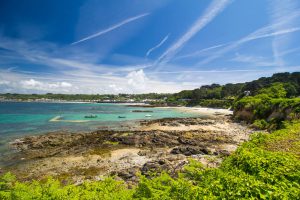 They are relatively small and may seem quite remote and difficult to get to with your caravan. But don’t overlook the possibilities of a visit – the Channel Islands are probably like nowhere else you’re likely to go and combine a sense of foreign travel, without actually leaving Britain, so you’ve no foreign language to learn.
They are relatively small and may seem quite remote and difficult to get to with your caravan. But don’t overlook the possibilities of a visit – the Channel Islands are probably like nowhere else you’re likely to go and combine a sense of foreign travel, without actually leaving Britain, so you’ve no foreign language to learn.
The islands lie in the Bay of St Malo, about 80 miles south of the coast of England, but only 19 miles from France.
The location gives away something of the fascinating history of the islands, which were once a part of the French region of Normandy. When the Duke of Normandy – William the Conqueror, later King William I – invaded England in 1066 he retained his titles in Normandy, including the Channel Islands.
Thanks to that historic connection, and having France as the closest neighbour, there are still native inhabitants of both Jersey and Guernsey who speak an ancient patois of Norman French – Jèrriais, in Jersey, and Guernésiais, in Guernsey.
Many centuries after the Norman invasion, and the clear separation of France and England, the Channel Islands remain part of the British Isles. The Queen is monarch of the islands, but Jersey and Guernsey each have their own, independent parliamentary democracies, so have no Member of Parliament at Westminster.
Parliamentary independence also extends to financial administration, so that although the Channel Islands raise their own taxes, there is no VAT.
The Channel Islands are made up of Jersey – the biggest of the islands – and the group of smaller islands known as the Bailiwick of Guernsey (which comprises the islands of Guernsey itself, the most northerly of the Channel Islands, Alderney and Sark).
All are small islands – Jersey, for example is only 45.5 square miles in area – and mostly rural and semi-rural. The exceptions are the “capital” towns of St Helier in Jersey and St Peter Port in Guernsey.
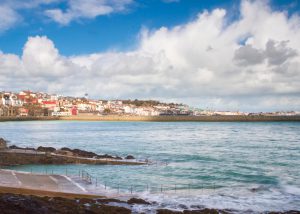 It means that almost all roads in all of the islands are quite narrow and traffic slow-moving. Guernsey, for example, has an island-wide speed limit of just 35 mph, while in Jersey it is 40mph. Small and winding lanes make driving with a caravan difficult, of course, and this is the main reason for caravans being limited to Jersey, but otherwise impossible throughout the Bailiwick of Guernsey. The island of Sark, for instance, has no road traffic at all, only tractors, bicycles and horse-drawn carriages, whilst Alderney’s only previous site for caravans has now become one for tents only.
It means that almost all roads in all of the islands are quite narrow and traffic slow-moving. Guernsey, for example, has an island-wide speed limit of just 35 mph, while in Jersey it is 40mph. Small and winding lanes make driving with a caravan difficult, of course, and this is the main reason for caravans being limited to Jersey, but otherwise impossible throughout the Bailiwick of Guernsey. The island of Sark, for instance, has no road traffic at all, only tractors, bicycles and horse-drawn carriages, whilst Alderney’s only previous site for caravans has now become one for tents only.
When you are caravanning in the Channel Islands, therefore, your base is on one of the sites on Jersey. But none of the other Channel Islands is far away and day trips to Guernsey, Sark or Alderney are well within reach, by local aeroplane or – a more leisurely – boat trip.
For that matter, neither is the historic French port of St Malo that far away and ideal for a day trip into foreign parts.
What you need before you go
Whenever you are preparing your caravan for any kind of outing, there are a number of things you need to do before getting under way.
That is especially true if you are planning to take your caravan across the sea, and perhaps even more important if you have chosen to take your holiday in the unfamiliar environment of the Channel Islands:
Passports
- the Channel Islands are part of the British Isles, so British citizens are not required to hold or show a passport on entry. However, you are required to bring some form of photographic ID.
Driving Licences
- this might take the shape of your British driving licence, for example, since at the time of writing it is entirely acceptable for driving on the roads in any part of the Channel Islands;
Car insurance
- just as anywhere else in the British Isles, the law requires that you have a minimum of third party insurance to drive your car, and you continue to be covered by your normal motor insurance policy;
- some areas, however, do require you to have a Green Card. Check with the relevant authorities if you are unsure;
Caravan insurance
- it is more important than ever that you check your touring caravan insurance is fully up to date and sufficient to cover the risks of loss or damage your present caravan may face – both during the ferry crossing and when negotiating the island’s narrow lanes;
Caravan permit
- the Caravan Club points out that whilst you are allowed to take your caravan to Jersey, you need a permit from the local authorities to do so;
- this rarely poses a problem, since the caravan site at which you are making your booking typically acquires the necessary permit on your behalf;
- you are allowed to pitch on a registered campsite only, keep it there throughout your stay, and may only tow it for one journey from the port of St Helier and back;
- your caravan’s maximum stay on the island is 31 days;
- there are also size restrictions – your caravan must be no wider than 2.3 metres, no longer than 6.7 metres (excluding the A-frame or towing hitch), and the combined maximum length of the caravan and the vehicle towing it must be no more than 16.5 metres overall;
- Similar rules apply in Guernsey
Currency
- there is no need to worry about changing your English bank notes or coins, since all are accepted throughout the Channel Islands;
- both Jersey and Guernsey print their own notes and coins, however, so you are likely to receive these in change and will need to change them back into English notes for use at home;
Preparing the caravan
- in addition to the paperwork, of course, is the importance of thoroughly checking all safety systems on your caravan – roadworthiness is just as much a legal requirement in the Channel Islands as it is in the UK;
- our caravanning checklist may provide useful;
- bear in mind that whichever shipping line you use, there are likely to be restrictions on the carriage of butane gas cylinders – so check on the relevant rules and conditions to avoid being denied boarding.
With your paperwork and the caravan itself all in order, you can plan your travel to the Channel Islands – so just how do you get there?
Getting there
Very simply, you have the choice of either Poole in Dorset or Portsmouth in Hampshire to catch your ferry to St Helier in Jersey.
Both routes are operated by Condor and each one has approximately seven sailings (there and back) each week.
Ferry crossing times vary quite widely and can be quite long – especially from Portsmouth – so you might want to treat the passage as a mini-cruise. Portsmouth to Guernsey, for instance, may take about 7 hours, whilst Poole to Jersey may be as fast as 4½ hours.
Condor
When booking with Condor ferries (UK to Jersey or France to Jersey) there are a number of important points to keep in mind:
- inform the company of the exact dimensions (length and height when making your book – this determines the price of the fare;
- the total length of the caravan and the vehicle towing it must not exceed 13.5 metres;
- the laden weight of the caravan must not exceed 3.5 tonnes;
- you may transport one gas cylinder, up to 5 kilograms in weight, which must be kept turned off for the duration of the sailing.
Jersey
Destination idea
- Rozel Camping Park – awarded a prestigious five pennants by the AA, Rozel campsite is in the parish of St Martin, in the northeast of the island;
- the site has a large heated swimming pool, shop and well-equipped play area for children;
- pitches have electric hook-ups, are spread over four main fields, and overlook the St Malo Bay to the French coast;
- The Palms – is in the northwest of the island, between the picturesque villages of Grève de Lecq and St Ouen;
- although one of the furthest places you can travel from the harbour at St Helier, the drive still only takes about 20 minutes;
- a feature of this site is an emphasis on totally unwinding and relaxing in a tranquil setting through natural remedies such as meditation, yoga and massage – there are even onsite therapists on hand to help you tune to the peacefulness of the environment;
- if you prefer to do your own relaxing, walking, swimming or any other water sport, the huge sweep of St Ouen’s Bay is only a mile away – unspoilt, golden sands stretch for 5 miles (so known to the locals as “five-mile beach);
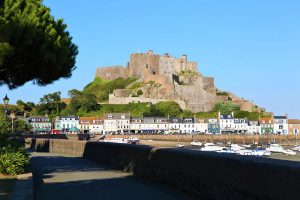 Though you have to leave your caravan where it is pitched throughout your stay in the island, there is plenty to explore by car, by public transport, or on foot.
Though you have to leave your caravan where it is pitched throughout your stay in the island, there is plenty to explore by car, by public transport, or on foot.
For such a relatively small island, Jersey has a wealth of variety, scenery and opportunities for activities of every kind.
The sea is never more than 10 minutes away and many a winding country lane opens up to clifftop views – either to the open sea or across the Bay to the French coast.
It is also an ideal, family-centred destination, with a zoo (founded by the well-known Gerald Durrell), a dinosaur trail, boat trips out to see the wild dolphins play, castles to clamber over and any number of activity days out.
The Bailiwick of Guernsey
Leave your caravan where it is and plan a day trip to one of the islands in the Bailiwick of Guernsey – preferably by pleasure boat, when the sea’s not too rough.
Sark
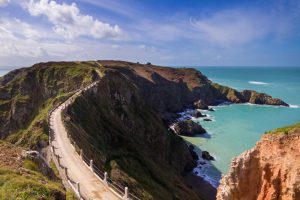 A favourite destination is the island of Sark, mid-way between Jersey and Guernsey.
A favourite destination is the island of Sark, mid-way between Jersey and Guernsey.
It describes itself as “a world apart” and this becomes immediately clear the moment you step off the boat. There are no cars to disturb the peace, for one thing, just the occasional tractor on the land, bicycles and more horse-drawn carriages than you could shake a stick at – the local tourist board quite rightly describes it as the jewel in the crown of the Channel Islands.
The island offers ideal walking country, with quiet valleys leading down to crystal clear waters or upland paths opening out onto stunning views from the cliffs. Cross from Sark to the peninsula of Little Sark via La Coupée – if you dare! This is a causeway – in parts only 3 metres wide – more than 260 feet above the sea. Just don’t attempt to make the crossing in a horse-drawn carriage.
A single day allows you to walk from one end of the island to the other and discover much of what it has to offer.
Guernsey
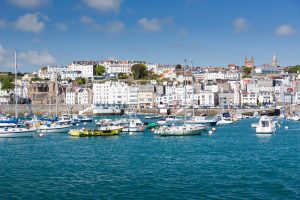 Guernsey is a different matter. Although still a small island, you might want to spend more than a day with this neighbour of Jersey’s.
Guernsey is a different matter. Although still a small island, you might want to spend more than a day with this neighbour of Jersey’s.
The islands are certainly different, with Guernsey seemingly more peaceful, quiet and run at a slower pace. There are cliffs in the south and open heath leading to the wide expanse of L’Ancresse Bay in the north. The capital, St Peter Port, is where the boat will land and sightseeing in this very attractive harbour town might easily take up a large part of your day.
As in Jersey, reminders of the German occupation during the Second World War are never far away. So, if you are a history buff, you may find more than enough to explore and sites to scramble over.
Yet another – this time very short – boat trip, will take you to the heavenly island of Herm. Once again, it is traffic-free and has enviably golden sands for beaches.
There is great rivalry between Guernsey and Jersey – Jerseymen refer to stubborn “Guernsey donkeys”, whilst Guernseymen refer to Jersey “crapauds” (the French for “toads”).
Alderney
Alderney is the most northerly of the Channel Islands and one that is closest to France – only 8 miles away.
The island is very small – three miles long by about 1½ miles wide.
It is also remote – and for that reason, has avoided a lot of mainstream tourism. One of its claims to fame is that cricketer Ian Botham takes his holidays there.
If you decide to visit Alderney for the day, the distance and usually quite rough sea-crossing means that you are best advised to hop on a plane to take you there – flying time about 15 minutes.
Summary
When planning your next touring caravan holiday, the Channel Islands might not immediately spring to mind.
But the experience is likely to be different to any other you might encounter in the British Isles – a familiarly British feel and language, but a hint of the foreign, too.
You are saved the hassle of actually towing your caravan on any tour of these small islands – thanks to the local bylaws of Jersey (which permits caravan use) and Guernsey (which does not).
Getting there by ferry is likely to be a sufficient adventure to add to that feeling of escaping to an entirely different place – and that is likely to be accentuated once you arrive.
From one of the beautiful caravan sites on Jersey, you may explore the whole of the Channel Islands at your leisure.
Please note that the information is correct as at the time of writing, but may be liable to change. Please always carry out your own research before travelling.

